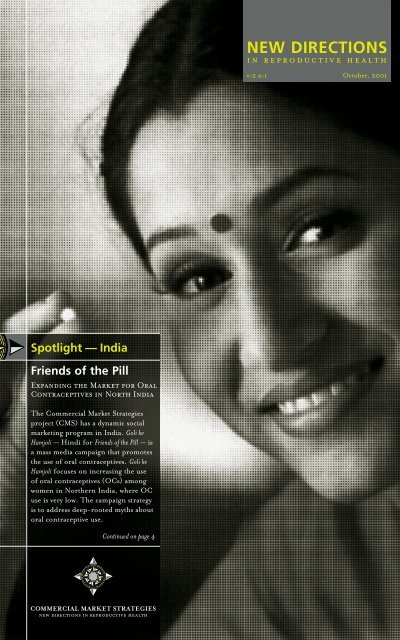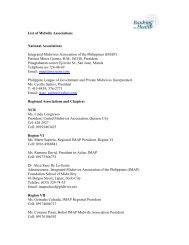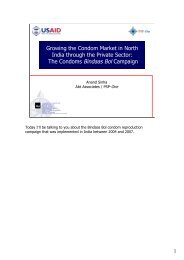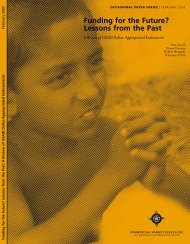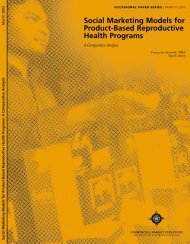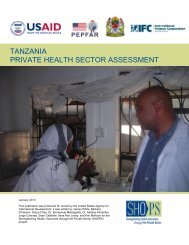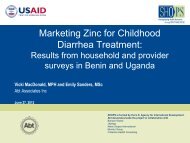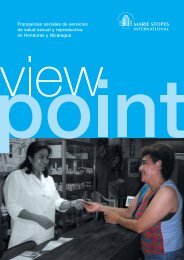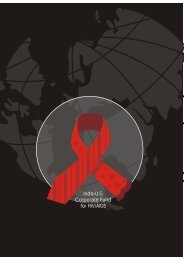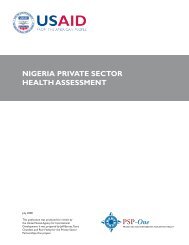new directions - (SHOPS) project
new directions - (SHOPS) project
new directions - (SHOPS) project
Create successful ePaper yourself
Turn your PDF publications into a flip-book with our unique Google optimized e-Paper software.
NEW DIRECTIONS<br />
in reproductive health<br />
v:2 n:1 October, 2001<br />
Spotlight — India<br />
Friends of the Pill<br />
Expanding the Market for Oral<br />
Contraceptives in North India<br />
The Commercial Market Strategies<br />
<strong>project</strong> (CMS) has a dynamic social<br />
marketing program in India. Goli ke<br />
Hamjoli — Hindi for Friends of the Pill — is<br />
a mass media campaign that promotes<br />
the use of oral contraceptives. Goli ke<br />
Hamjoli focuses on increasing the use<br />
of oral contraceptives (OCs) among<br />
women in Northern India, where OC<br />
use is very low. The campaign strategy<br />
is to address deep-rooted myths about<br />
oral contraceptive use.<br />
Continued on page 4<br />
COMMERCIAL MARKET STRATEGIES<br />
<strong>new</strong> <strong>directions</strong> in reproductive health
NEW DIRECTIONS<br />
in reproductive health<br />
v:2 n:1 October, 2001<br />
Spotlight — India<br />
1 Friends of the Pill<br />
2 From the Director<br />
3 Continuing a Strategic Partnership<br />
with Pharmaceutical Companies<br />
3 New Clinics making Positive Impact<br />
in Nicaragua<br />
8 Capital Doctor and Triple S<br />
9 New CMS Research Documents the<br />
Process of Contraception-Adoption<br />
10 CMS Publications<br />
12 Summa Foundation Loan to the<br />
Reproductive Health Association of<br />
Cambodia Contributes to its<br />
Financial Sustainability<br />
12 In Upcoming Editions<br />
in partnership with:<br />
Abt Associates Inc.<br />
Population Services International<br />
Meridian Group International, Inc.<br />
funded by:<br />
US Agency for International Development<br />
USAID Contract No.<br />
HRN-C-00-98-00039-00<br />
USAID CTO: Katharine Kreis<br />
Telephone:(202) 712-0943<br />
E-mail: kkreis@usaid.gov<br />
Commercial Market Strategies Office<br />
1001 G Street NW, Suite 400W<br />
Washington DC, 20001-4545<br />
Telephone: (202) 220-2150<br />
Fax: (202) 220-2189<br />
Web: www.cms<strong>project</strong>.com<br />
New Directions is produced by CMS<br />
Communications Director, Sue Wood.<br />
E-mail: swood@cms<strong>project</strong>.com<br />
Printed on 100% post-consumer recycled paper<br />
with soy based inks.<br />
From the Director<br />
CMS operates in over 15 countries and in the course of<br />
working through the ongoing implementation challenges of<br />
a <strong>project</strong> of this breadth it is always satisfying to pull back<br />
and look at the actual health impact of our work. How are<br />
we changing people’s lives What works What doesn’t<br />
Our Goli ke Hamjoli campaign promoting the use of oral<br />
contraceptives in India is an example of research, management<br />
and creativity working at their best. The campaign is everchanging<br />
to meet the needs of the community and address<br />
the issues uncovered in monitoring and evaluating our work.<br />
When I visited the program office this spring I was impressed<br />
with the enthusiasm of the CMS team. Since that trip we have<br />
continued monitoring and evaluating the campaign and are<br />
pleased to spotlight Goli ke Hamjoli in this issue of New Directions.<br />
Also, in Morocco, the Kinat Al Hilal campaign was given a boost<br />
with the re-commitment of partner pharmaceutical companies<br />
to maintain low prices and contribute return-to-<strong>project</strong><br />
funds for the continued advertising of oral contraceptives.<br />
A Memorandum of Understanding was signed in June<br />
between CMS and the participating manufacturers. This<br />
event went practically un-noticed…until we really thought<br />
about what a re-commitment from a pharmaceutical company<br />
says about our work. The partnership is working and more<br />
Moroccans have access to affordable contraceptives as a result<br />
of it. So, in this last quarter of the third year of our <strong>project</strong>, I<br />
can honestly say we are having a positive impact on the health<br />
of people in our <strong>project</strong> areas.<br />
On page seven of this issue of New Directions we are offering<br />
you an opportunity to order CMS publications. These<br />
documents are free of charge and you can use the enclosed<br />
insert to mail in your request. You can also read about our<br />
programs on our web site at www.cms<strong>project</strong>.com. I hope you will<br />
enjoy this fourth edition of New Directions. I welcome your<br />
comments and suggestions for upcoming editions.<br />
Lizann Prosser<br />
Project Director, Commercial Market Strategies<br />
Deloitte Touche Tohmatsu<br />
lprosser@cms<strong>project</strong>.com<br />
2<br />
<strong>new</strong> <strong>directions</strong><br />
October, 2001
Continuing a Strategic Partnership with<br />
Pharmaceutical Companies<br />
Keeping the Pill Accessible in Morocco<br />
Since 1992 the Moroccan Kinat Al Hilal (Pill of the Moon) brand of oral contraceptives has<br />
been successfully sold through a social marketing arrangement with the Wyeth and<br />
Schering pharmaceutical companies. In May of 2001 both manufacturers signed<br />
a Memorandum of Understanding (MOU) with CMS establishing the terms and<br />
conditions for the continued social marketing of their low-dose brands, Minidril<br />
(Wyeth) and Microgynon (Schering), under the Kinat Al Hilal brand. This re-commitment<br />
by the pharmaceutical companies demonstrates the success of the partnership. Both<br />
manufacturers agreed to continue to sell their pills at a rate of 8.8 Moroccan Dirhams<br />
per cycle (80 cents US). In fact, Wyeth and Schering have not raised the price of these<br />
products since 1998. Additionally, the manufacturers agreed to continue setting aside<br />
five percent of their gross sales in a return to <strong>project</strong> fund (RPF) used for advertising<br />
and promoting the Kinat Al Hilal umbrella brand.<br />
To overcome advertising restrictions — the<br />
brand-specific advertising of pharmaceuticals<br />
is not permitted in Morocco — an<br />
umbrella name, Kinat Al Hilal (Pill<br />
of the Moon), and logo were created. The<br />
moon provides a symbolic link with the<br />
monthly cycle and serves as a reminder<br />
for taking the pill.<br />
The <strong>new</strong> MOU also allows CMS to use the return to <strong>project</strong> funds from 1999 and<br />
2000 sales to develop a <strong>new</strong> advertising strategy and purchase media for the current<br />
Kinat Al Hilal campaign.<br />
For more information about the pharmaceutical partnerships in Morocco or<br />
within the CMS <strong>project</strong> please contact Vicki Baird at v.baird@meridian-group.com<br />
or Dr Mohamed Ktiri (in Morocco) at mktiri@cms.org.ma.<br />
New Clinics Making Positive Impact in Nicaragua<br />
CMS is working with PROFAMILIA, a Nicaraguan family planning NGO, to upgrade<br />
and expand their services with six <strong>new</strong> primary care clinics in Hurricane-Mitch<br />
affected areas. In March 2001 CMS opened the first clinic in Tipitapa. Since then,<br />
two more clinics have opened: one in Esteli and another in Sebaco. (See the June<br />
2001 edition of New Directions for the full story.) The <strong>new</strong> state-of-the-art facilities —<br />
constructed with the same interior layout, exterior design, signage and services —<br />
offer a broad range of services and complement the existing 12 PROFAMILIA clinics.<br />
In the first six months over 4,000 patients received health care in the three <strong>new</strong> PRO-<br />
FAMILIA clinics — over 2000 patients in Tipitapa alone! While operating costs have<br />
varied, the overall cost recovery ratio for all three clinics has exceeded expectations.<br />
CMS is aggressively promoting the brand equity of PROFAMILIA and uses a franchise<br />
model for marketing services — so every time a person enters a PROFAMILIA clinic<br />
they know exactly what high quality services they can expect. Marketing efforts have<br />
focused on “promoters” who visit families in their homes, collect information about<br />
health needs and encourage clinic visits when needed. Additional promotion through<br />
radio jingles, television spots, outdoor video and special “combo” packages familiarize<br />
the community with the PROFAMILIA brand name and services.<br />
We will update you on further developments of the PROFAMILIA clinics as they<br />
open. If you’d like information about CMS’s work in Nicaragua please contact Kelly<br />
Wolfe at kwolfe@cms<strong>project</strong>.com or Pilar Sebastian (in Nicaragua) at cms@cablenet.com.ni.<br />
The PROFAMILIA clinic in Tipitapa.<br />
Based on a franchise model, all of the <strong>new</strong><br />
PROFAMILIA clinics have the same<br />
layout, design, signage and services.<br />
October, 2001<strong>new</strong> <strong>directions</strong> 3
Spotlight – India<br />
Friends of the Pill (continued from front cover)<br />
According to the Memorandum of<br />
Understanding with partner pharmaceutical<br />
companies, the campaign<br />
“overbrands” low-dose oral contraceptive<br />
packaging with the Goli Ke<br />
Hamjoli logo (above). This provides<br />
consumers with an important visual<br />
link to the mass media campaign while<br />
increasing sales and brand equity for<br />
the manufacturers.<br />
1 Focus groups were used at each step to<br />
understand needs, fears and barriers to<br />
OC use, identify the target audience,<br />
test advertising concepts and prototypes,<br />
and monitor the campaign.<br />
2 A Goli Ke Hamjoli representative<br />
holds generic packages of contraceptive<br />
pills during a training session for pharmacists.<br />
The program was developed<br />
to increase oral contraceptive use in<br />
Northern India by promoting the entire<br />
category of low-dose pills and not just<br />
one specific brand.<br />
To put the CMS Goli ke Hamjoli campaign in a historical context, it should be noted<br />
that social marketing has been going on in India since the 1960s. The first social<br />
marketing campaign used a government-subsidized brand of condoms sold<br />
through a variety of outlets. At that time, most Indian family planning programs<br />
focused on sterilization and efforts to promote birth spacing methods met with<br />
limited success. Consequently, the use of methods such as IUDs and OCs were<br />
extremely low. But in 1998 a National Family Health Survey indicated that even<br />
though the use of oral contraceptives in India was very low (2.1 percent in 1998)<br />
the propensity to try oral contraceptives was very high. And a few years earlier<br />
(1992), the government of India had reclassified low-dose OCs as over-thecounter<br />
drugs. This suggested both a strong barrier to behavior change with<br />
respect to oral contraceptives as well as an opportunity for marketing them.<br />
India’s ICICI bank — under the USAID-funded Program for Advancement of<br />
Commercial Technologies (PACT) - Child Reproductive Health (CRC) <strong>project</strong> —<br />
engaged CMS to assist in the expansion of the private sector market for oral<br />
contraceptives in eight states: Madhya Pradesh, Bihar, Rajasthan, Jharkhand,<br />
Uttaranchal, Uttar Pradesh, Chattisgarh and Delhi.<br />
To do this CMS developed a campaign plan to promote “generic” use of lowdose<br />
OCs through advertising, public relations and training. In the campaign<br />
plan, commercial and social marketing firms could promote their own brands<br />
under the umbrella of this campaign. The leading pharmaceutical firm, Wyeth<br />
Lederle agreed to intensify promotion and distribution of their own brand in<br />
North India as a partner to the campaign.<br />
Initial Steps in Developing the Oral Contraceptive<br />
Promotion Campaign<br />
The first step in the CMS/India <strong>project</strong> was to conduct research among OC users<br />
and potential users. To understand the needs and fears regarding OCs and identify<br />
the target audience, CMS used a mix of one-on-one interviews and focus group<br />
discussions with married women, their husbands, their mothers-in-law and<br />
1 2<br />
4<br />
<strong>new</strong> <strong>directions</strong><br />
October, 2001
Country Name: Republic of India<br />
Population: 1033 million (mid-2001 estimate)*<br />
Capital: New Delhi<br />
Area Comparative: Slightly more than one-third the size of the United States<br />
GNI PPP per Capita: $2,230 (USD, 1999)*◊<br />
Total Fertility Rate: 3.2*<br />
Infant Mortality Rate: 70 per 1,000*<br />
Contraceptive Prevalence Rate: 48 (all methods, married women)*<br />
Percent of Population with HIV/AIDS: 0.7*<br />
Source:<br />
* Population Reference Bureau: 2001 World Population Data Sheet<br />
◊ Gross National Income per capita adjusted for purchasing power parity (PPP). For more information see www.prb.org.<br />
gynecologists. The advertising firm, Ogilvy & Mather, observed all of the focus<br />
groups sessions via closed-circuit cameras. Focus groups revealed two primary<br />
barriers to OC use. First, fear of short-term side effects such as nausea, weight gain and<br />
dizziness were identified as irritants in daily life. Second and more serious was<br />
concern about long-term side effects such as infertility and permanent physical damage.<br />
These fears were in part due to the side effects of high-dose OCs previously<br />
available on the Indian market. Another finding that was instrumental in shaping<br />
the initial campaign was articulated during the focus group sessions: “…a woman who<br />
enters a <strong>new</strong> house after marriage experiences many changes and needs time to adjust to her environment<br />
and the roles she is expected to adopt….” Based on this insight, CMS and Ogilvy & Mather<br />
then developed advertising concepts and prototypes that were tested on other focus<br />
groups before the initial launch. The <strong>new</strong> campaign, targeted to women between<br />
age 18–29 in urban areas, positioned the pill as a companion to women and<br />
couples and called itself Goli ke Hamjoli, which in Hindi means Friends of the Pill.<br />
To augment the mass media consumer campaign, a series of public relations and<br />
training activities were targeted at pharmacists and doctors. These health care<br />
providers were identified as the key opinion leaders and gatekeepers for oral<br />
contraceptive use in Northern India.<br />
3 A television ad targeting young urban<br />
couples. Follow-up research on the<br />
first round of Goli Ke Hamjoli<br />
mass media ads revealed that family<br />
planning decisions were being made<br />
by couples rather than just women.<br />
4 An Indian celebrity talks about Goli<br />
Ke Hamjoli — televised celebrity<br />
endorsements address side effects and<br />
raise awareness of the ease of use of<br />
the <strong>new</strong> generation of low-dose contraceptive<br />
pills.<br />
5 Doctors attend a Goli Ke Hamjoli<br />
conference. Public relations activities<br />
like conferences and training sessions<br />
support the mass media campaign.<br />
Goli Ke Hamjoli is cast as a<br />
“movement” involving doctors,<br />
pharmacists, opinion leaders, civic<br />
groups, health organizations and<br />
the media to help educate couples<br />
interested in oral contraceptives.<br />
Monitoring the Advertising Campaign<br />
The first Goli ke Hamjoli mass media/advertising blitz in 1998 used television ads<br />
aired on government television channels as well as satellite, Sony, Zee, Star and<br />
local cable TV networks. The ads used the themes of safety and reassurance to address<br />
anxiety about side effects and the role of a <strong>new</strong> bride and her decisions about<br />
family planning. However, follow-up research on the campaign revealed that<br />
married couples were making family planning decisions, not just women. Based<br />
on this finding the ads were modified to include a young urban couple.<br />
3<br />
In mid-1999, the campaign used celebrity endorsements to raise awareness of the<br />
<strong>new</strong> generation of low-dose pills. The celebrities addressed side effects such as<br />
weight gain and highlighted the reversibility and ease of oral contraceptive use.<br />
4<br />
5<br />
October, 2001<strong>new</strong> <strong>directions</strong> 5
TRACKING STUDIES:<br />
Post-viewing Behavior<br />
jan july feb<br />
Base: All who saw the ad 1999 1999 2000<br />
Use OCs 4% 8% 11%<br />
Intend to use 27% 21% 15%<br />
Discontinued users 5% 3% 3%<br />
Posters from the initial mass media campaign positioned the pill as a companion and “friend” to urban women aged 18–29.<br />
Recent qualitative follow-up research suggests that there are two audiences for the<br />
Goli ke Hamjoli campaign. The first group, intenders, is aware of the benefits of modern<br />
contraceptive methods but need reassurance and information on the regime and<br />
safety. The second group, non-users, use traditional methods and need to be convinced<br />
of the benefits of using modern contraceptives, such as peace of mind. A set of five<br />
television ads targeting these two groups was released in February 2001. Three of the<br />
ads have concise information on OC use and safety and are targeted at turning intenders<br />
into users. The other two ads are more emotive and address the concerns of non-users.<br />
The television ads have over 80 percent recall among target women in program cities.<br />
Recent sales data show that the campaign has been successful in growing the oral<br />
contraceptive market within the target audience.<br />
Training and Detailing<br />
A Goli Ke Hamjoli “promoter”<br />
on a detailing visit provides information<br />
to a pharmacist. Over 100<br />
promoters visit doctors and pharmacists<br />
in the <strong>project</strong> area and answer<br />
questions about the <strong>new</strong> generation<br />
of low-dose contraceptives.<br />
The Goli ke Hamjoli program does not promote a specific brand, but rather<br />
promotes the entire category of low-dose pills. So doctors and pharmacists —<br />
the gatekeepers — need information about these <strong>new</strong> products. As part of the<br />
agreement with OC manufacturers, CMS has engaged over 100 “promoters” to<br />
detail neighborhood doctors and pharmacies in the <strong>project</strong> area. These promoters<br />
provide specific information about low-dose oral contraceptives. They answer<br />
questions about the differences in side effects between this <strong>new</strong> low-dose product<br />
and the higher-dose pills in the past. The Goli ke Hamjoli promoters’ work has<br />
become invaluable to the manufacturers sales efforts. Today most manufacturers’<br />
representatives promote their brands as “partners” with Goli ke Hamjoli. They see the<br />
brand equity value of associating themselves with such a successful campaign.<br />
To date, the Goli ke Hamjoli campaign has trained over 30,000 pharmacists<br />
and 22,000 traditional doctors on the issues surrounding low-dose oral<br />
contraceptives. Briefing sessions have been held in 12 cities for leading local<br />
civic groups including the Indian Medical Association, the Rotary Club, the<br />
Lions Club and others. Updates on the Goli ke Hamjoli program have been mailed<br />
to over 27,500 doctors and over 320 of the area’s top doctors have endorsed<br />
6<br />
<strong>new</strong> <strong>directions</strong><br />
October, 2001
Goli ke Hamjoli and are offering free counseling. Since its inception over 300<br />
articles on the Goli ke Hamjoli program and oral contraceptive pills have appeared<br />
in Indian <strong>new</strong>spapers and women’s magazines.<br />
Awards and Recognition<br />
The Goli ke Hamjoli campaign was named Healthcare Campaign of the Year at the 1999<br />
Asian Public Relations Awards and won India’s Abby Award from the Bombay Ad<br />
Club for Best Social Concern Campaign. The Goli ke Hamjoli campaign has produced<br />
what is often referred to as a “halo-effect.” Overall commercial sales of oral<br />
contraceptives in the <strong>project</strong> area have increased. More importantly, the campaign has<br />
proven to be such a success that <strong>new</strong> pharmaceutical manufacturers have signed on —<br />
establishing a solid role for the private sector and giving even wider access to oral<br />
contraceptives in Northern India. “The private sector must see the benefit of a partnership,” says<br />
Dr Rita Leavell, CMS India Country Director, “since so many firms have asked us to ‘do a Goli<br />
ke Hamjoli’ for their products!”<br />
The CMS experience in Northern India illustrates the positive effects of combining<br />
creative advertising with continued research, monitoring and evaluation to bring<br />
about a very positive health impact in a challenging environment.<br />
For more information about the Goli ke Hamjoli campaign please contact Craig<br />
Carlson (in Washington, DC) at ccarlson@cms<strong>project</strong>.com or Rita Leavell (in India)<br />
at rleavell@compuserve.com.<br />
1<br />
1 The Goli Ke Hamjoli campaign<br />
has trained over 30,000 pharmacists<br />
(chemists) about OCs using<br />
printed guides, briefing sessions<br />
and detailing visits. Early research<br />
revealed that doctors and pharmacists<br />
were the “gatekeepers” — influential<br />
sources of information for women and<br />
couples considering using the pill.<br />
2 A billboard promoting Goli Ke<br />
Hamjoli in Jaipur, August 2001.<br />
There have been over 300 <strong>new</strong>spaper and magazine<br />
articles about the program — this June 15, 2000 issue of<br />
A&M (Advertising and Marketing, and Indian magazine)<br />
announces that Goli Ke Hamjoli serves “The Need of The<br />
Day” in its effort to “educate Indian women about the<br />
benefits of the pill.” The article asserts that the campaign<br />
“may end up lending a hand to economic development”<br />
and concludes by saying “And let’s hope it reaches every<br />
Indian ear. For the time is now. And Goli Ke Hamjoli is a<br />
commendable beginning. Let others follow.”<br />
2<br />
October, 2001<strong>new</strong> <strong>directions</strong> 7
Capital Doctor and Triple-S<br />
Call-in Radio Programs in Uganda are Wide-Reaching and<br />
Provide a Platform for Straight Talk about Sexual Health.<br />
Understanding the specific questions people have about health and sexuality is the<br />
cornerstone to developing effective public health campaigns. The CMS Uganda<br />
<strong>project</strong> office offers another break-through method for doing just that.<br />
CMS/Uganda has developed one of the most successful radio programs in the<br />
region. Capital Doctor is a call-in radio show with a medical doctor acting as the host.<br />
The show, sponsored by Protector condoms (the CMS brand), airs every Tuesday from<br />
8:00 to 9:00 pm on Capital Radio, an FM station based in the capital, Kampala.<br />
Capital Radio covers all of Uganda as well as parts of neighboring Kenya and<br />
Tanzania and so Capital Doctor reaches an audience of about nine million people.<br />
1 Straight Talk, the monthly tabloid<br />
for adolescents published by the<br />
Straight Talk Foundation, promotes<br />
the Capital Doctor and Triple-<br />
S radio shows while reinforcing their<br />
positive reproductive health messages.<br />
2 A girl in a teen center in Kampala,<br />
Uganda, listens to the Capital<br />
Doctor call-in radio show. Most of<br />
the questions for the doctors hosting the<br />
program come from adolescent women.<br />
The Capital Doctor hosts are Dr Donna Kabatesi, a specialist in STD management,<br />
and Dr Elioda Tumwesigye, a physician and epidemiologist with vast experience<br />
in STD research and prevention. The lively Capital Doctor show format features<br />
popular music and promotional advertising for the Protector condom. The doctors<br />
provide detailed answers to questions that are submitted by the audience either<br />
via telephone or mail. The majority of questions on the show come from<br />
women. Most questions are related to HIV/AIDS, sexuality, lower abdominal<br />
pain, menstruation, infertility and masturbation. Callers also have many<br />
questions regarding malaria.<br />
To support the Capital Doctor show, the Straight Talk Foundation, a local NGO<br />
publishes monthly tabloid paper called Straight Talk. This paper is targeted<br />
toward adolescents and also features candid questions and detailed answers<br />
about sexuality, reproductive health and peer pressure. Capital Doctor refers to<br />
the Straight Talk publication on the air as a means of reinforcing positive<br />
reproductive health messages.<br />
CMS is also working with Dr Tumwesigye on a radio program called Triple-S (Stay<br />
Safe and Smart). This program is aired on Radio-West in the Western Ugandan<br />
town of Mbarara. The Triple-S format is similar to Capital Doctor and targets youth<br />
with topics such as setting academic goals, intelligent choices about alcohol and<br />
drug use, malaria, HIV/AIDS and STDs.<br />
1<br />
For more information about the Capital Doctor or Triple-S programs in Uganda<br />
please contact Steven Shalita (in Uganda) at sshalita@cms<strong>project</strong>.co.ug. For more<br />
information about the CMS programs in Africa please contact Rudolph Chandler<br />
at rchandler@cms<strong>project</strong>.com.<br />
8<br />
2<br />
<strong>new</strong> <strong>directions</strong><br />
October, 2001
New CMS Research Documents the Process of<br />
Contraception-Adoption<br />
Women or couples considering contraceptive use typically work through a number<br />
of decisions including deciding to adopt contraception (or not to), choosing a<br />
method, and, over time, deciding to continue, switch methods, or stop. In July<br />
2001, CMS/Jordan released a study documenting the steps Jordanian women go<br />
through in the contraception-adoption process and identifying critical decision<br />
points and influential sources of information.<br />
Dr Michael Bernhardt, CMS/Jordan, and Dr Mousa Shteiwi of the University of<br />
Jordan designed the study. Researchers used personal interviews to determine who<br />
women talked with about using contraception and choosing a method, why they<br />
switched or stopped, and their level of satisfaction with both the advice received<br />
and the method itself.<br />
“This work is important because it tells us who women turn to when making family planning decisions,”<br />
says Dr Ruth Berg, CMS Research Director. “If we know who women talk to and whose<br />
advice they trust we can then reach out to these advisors. This information helps us design programs that<br />
allow women to choose methods that best fit their needs.”<br />
The study found that while the husband is influential in deciding to begin or stop<br />
using contraception, he has less to say about the particular contraceptive method<br />
chosen. In fact, 84 percent of the women surveyed stated that in preliminary<br />
discussions their husbands did not suggest a particular method. For technical<br />
discussions and advice regarding method choice women turn to physicians,<br />
specifically general practitioners specializing in women’s health (as opposed to specialists like<br />
OB/GYNs). Women have the greatest trust in general practitioners — so these<br />
doctors are pivotal actors in the contraception-adoption process and successful<br />
family planning programs will need to reach this group. Pharmacists were found<br />
to have a negligible role in the decision-making process.<br />
A female community health worker<br />
answers questions about contraceptive use<br />
during a home visit in Jordan. Door-todoor<br />
visits provide women with the<br />
opportunity to ask questions, discuss their<br />
health concerns and get referrals to local<br />
clinics and physicians.<br />
The 1997 Demographic Health Survey in<br />
Jordan reported that 20 percent of all<br />
births in the previous five years were<br />
mistimed, and 17 percent were unwanted.<br />
“This work is important because it tells us who women<br />
turn to when making family planning decisions.”<br />
Sixty-four percent of the women surveyed abandoned the first method they chose<br />
within a year. But then almost all of the women who stopped subsequently<br />
adopted another modern method. So even though women gave up on a method,<br />
they didn’t give up on family planning — they just switched. In fact, 95 percent of the<br />
women surveyed said that they were satisfied with their <strong>new</strong>, second method<br />
choice. This means that the bulk of women who were dissatisfied with their first<br />
family planning choice did not revert to traditional methods.<br />
The full report, The Contraception-Adoption Process in Jordan, provides background<br />
information and details the research objectives, sample and methodology. The<br />
methods recommended by the different advisors at each phase of the process are<br />
documented as well as reasons for discontinuation. The report also discusses the<br />
respondents’ perception of the credibility of sources of information and the<br />
criteria used for selecting a provider.<br />
To order a copy of the report please contact Christine Préfontaine at (202) 220-<br />
2174 or cprefontaine@cms<strong>project</strong>.com. You can learn more about this study and CMS<br />
activities in Jordan by contacting Craig Carlson at ccarlson@cms<strong>project</strong>.com or Dr<br />
Michael Bernhardt (in Jordan) at mbernhart@aol.com.<br />
October, 2001<strong>new</strong> <strong>directions</strong> 9
CMS Publications<br />
The following CMS print publications are available and free of charge. Please<br />
mail in the enclosed card to indicate which publication you would like to receive.<br />
We maintain a current publications list in the Resources section of our web site<br />
at www.cms<strong>project</strong>.com.<br />
Newsletters — New Directions<br />
Uganda<br />
Volume 1, Number 1<br />
September, 2000<br />
Morocco<br />
Volume 1, Number 2<br />
February, 2001<br />
Nicaragua<br />
Volume 1, Number 3<br />
June, 2001<br />
General<br />
Country Research Series<br />
Annual Report<br />
Commercial Market Strategies Year Two<br />
Annual Report. October 2000.<br />
Assessment Manual<br />
A Handbook for Conducting Private Sector<br />
Country Assessments. September 2000.<br />
Number One — Uganda<br />
Knowledge, Attitudes and Practices Related to<br />
Malaria and Insecticide Treated Nets in Uganda<br />
— Baseline Survey: December 1999 - January<br />
2000. Francis Okello-Ogojo,<br />
February 2001.<br />
Number Two – Jordan<br />
Perceptions of Contraceptives Among Women in<br />
Jordan: A Projective Study. Michael Bernhart<br />
& Nadine Khoury, March 2001.<br />
CMS Brochure<br />
Commercial Market Strategies: New Directions in<br />
Reproductive Health. An overview of CMS<br />
technical areas, 8 pages, multi-lingual<br />
(English, French and Spanish).<br />
Number Three – Jordan<br />
The Contraception-Adoption Process in Jordan.<br />
Michael Bernhart and Mousa Shtiewi,<br />
July 2001.<br />
HIV/AIDS Pocket Folder<br />
Commercial Market Strategies: An overview of how<br />
CMS is working with the private sector on<br />
prevention and treatment programs for sexually<br />
transmitted infections and HIV/AIDS around<br />
the world. September, 2001.<br />
CMS Technical Fact Sheets<br />
The CMS <strong>project</strong> has seven technical areas: Partnerships,<br />
Policy, NGO Sustainability, Corporate Social<br />
Responsibility, Provider Networks, Health Financing and<br />
Social Marketing. These technical areas are highlighted in<br />
individual factsheets within a CMS folder. September<br />
2001. If you require more than ten sets of these fact<br />
sheets please call us at: +(202) 220-2150.<br />
10<br />
<strong>new</strong> <strong>directions</strong><br />
October, 2001
Summa Foundation Publications<br />
Summa Brochure<br />
Summa Foundation: Banking on Health.<br />
An overview of the investment<br />
process, criteria, technical<br />
assistance and examples of<br />
borrowers, 8 pages.<br />
Investment Profile 1 – Uganda<br />
The Uganda Private Providers Loan Fund —<br />
A private sector intervention to improve<br />
women’s health: Using microcredit to improve<br />
and expand health practices that serve women<br />
and children.<br />
Case Study – Indonesia<br />
Indonesia Midwives Loan Fund: Can a<br />
Revolving Loan Fund be used to Encourage<br />
Private Midwifery Practices<br />
Program Research 1 – Uganda<br />
The Uganda Private Providers Loan Fund:<br />
Client Exit Interview Baseline Report — A<br />
Study of Exit Clients at Private Clinics in<br />
the Districts of Kampala, Mukono, Mpigi<br />
and Mbarara.<br />
Case Study – Kenya<br />
AAR Health Services, Kenya: Is the<br />
Provision of Financing a Cost-Effective<br />
Intervention to Motivate the For-Profit<br />
Health Sector in the Delivery of Family<br />
Planning Services<br />
Financing Sources<br />
Summa Financing Sources. A tool<br />
designed to assist the private and<br />
commercial health sector to identify<br />
sources of financing for healthcare<br />
activities in developing countries.<br />
Technical Papers<br />
Services Marketing<br />
Marketing Reproductive Health Services, Moving Beyond Traditional<br />
Social Marketing. Technical Advisory Group Proceedings,<br />
October 2001.<br />
Social Franchising to Expand Access — Pakistan<br />
Social Franchising as a Strategy for Expanding Access to Reproductive<br />
Health Services. A historical analysis of Population Service<br />
International’s Green Star service delivery network in Pakistan.<br />
Rehana Ahmed, MD, and Julie McBride, MPH,<br />
October 2001.<br />
The Role of Insurance Mechanisms in<br />
Improving Access<br />
The Role for Insurance Mechanisms in Improving Access to Private Sector<br />
Primary & Reproductive Health Care. Technical Advisory Group<br />
Proceedings, prepared by Rich Feeley, November 2000.<br />
October, 2001<strong>new</strong> <strong>directions</strong> 11
Summa Foundation Loan to the Reproductive<br />
Health Association of Cambodia Contributes to<br />
its Financial Sustainability<br />
Cambodia has the highest maternal<br />
mortality rate in South East Asia. The<br />
Reproductive Health Association of<br />
Cambodia (RHAC) has been dedicated<br />
to meeting the needs of the Cambodian<br />
people since 1997.<br />
The Summa Foundation<br />
provides financing and technical<br />
assistance to the private and<br />
commercial health sector in<br />
developing countries. For<br />
more information about<br />
the Summa Foundation visit<br />
www.summainvestments.org or<br />
contact Meaghan Smith at<br />
msmith@cms<strong>project</strong>.com or Carlos<br />
Carrazana at ccarrazana@<br />
cms<strong>project</strong>.com.<br />
In July 2001 the Summa Foundation disbursed a $150,000, 3.5-year loan to<br />
the Reproductive Health Association of Cambodia (RHAC). The loan was used<br />
to purchase RHAC’s main clinic and headquarters in Phnom Penh.<br />
During the turmoil of the Khmer Rouge, the Cambodian health care system was<br />
abolished. Less than 50 Cambodian doctors survived Pol Pot’s regime in the late<br />
1970s, which rejected conventional Western medicine and allowed only traditional<br />
healing methods.<br />
Since 1980 Cambodia has tried to re-build its health sector, but public services<br />
are still weak. As a result of this devastation, public health sector indicators are<br />
low. The total fertility rate is 4.1 and the contraceptive prevalence rate is 16<br />
percent for all married women using modern methods. In addition, Cambodia<br />
currently has the highest HIV/AIDS prevalence among Asian countries.<br />
In 1997, in this difficult environment, the Reproductive Health Association<br />
of Cambodia (RHAC) began operations. It is an indigenous not-for-profit<br />
organization, managed and staffed by Cambodians. RHAC provides health<br />
services through five clinics in four provinces of Cambodia and through a<br />
community outreach program. RHAC clinics provide family planning services,<br />
STI treatment and counseling, pre- and post-natal care, and HIV/AIDS<br />
counseling. RHAC also provides training in reproductive healthcare to other<br />
private and public sector health professionals. Today RHAC stands out for<br />
providing high quality affordable reproductive health services.<br />
As it strives to establish roots for longevity, RHAC is working towards financial<br />
sustainability. RHAC has already taken a number of steps to increase its sustainability<br />
and diversify its funding base. Following an assessment, the Summa Foundation<br />
recommended several additional steps, including a loan to purchase RHAC’s main<br />
clinic and headquarters. This Summa loan will increase RHAC’s institutional equity<br />
and reduce costs over time. To move RHAC closer to its goal of sustainability, the<br />
Summa Foundation will also provide technical assistance, including assistance in<br />
investing its cash reserves.<br />
12<br />
<strong>new</strong> <strong>directions</strong><br />
In Upcoming Editions of New Directions<br />
■ CMS is working with The Ghana Social Marketing Foundation (GSMF) on<br />
several fronts. Recently, the Summa Foundation provided a loan for the purchase of<br />
condoms to be socially marketed throughout the country and CMS hired full-time<br />
local representative to assist in the implementation of corporate social responsibility<br />
and health activities initiated by several commercial businesses. In the next edition of<br />
New Directions we will highlight these activities.<br />
■ CMS in Uganda will be launching a Clean Delivery Kit called New Maama in the<br />
Fall of 2001. New Maama is a simple, disposable kit designed reduce infections during<br />
the delivery of a baby (infection is a major cause of maternal and <strong>new</strong>born death).<br />
The New Maama <strong>project</strong> is in partnership with CARE’s International Community<br />
Reproductive Health Project (CREHP). The next edition of New Directions will include<br />
a status report on this <strong>new</strong> <strong>project</strong>.<br />
■ As part of CMS’s on-going assistance to four local NGOs in the Dominican<br />
Republic we conducted a business-planning workshop from August 27–29. The<br />
workshop was focused on training participants to write an effective business plan<br />
and there was also a module on corporate social responsibility. In the next<br />
edition of New Directions we will summarize the workshop highlights.<br />
October, 2001


